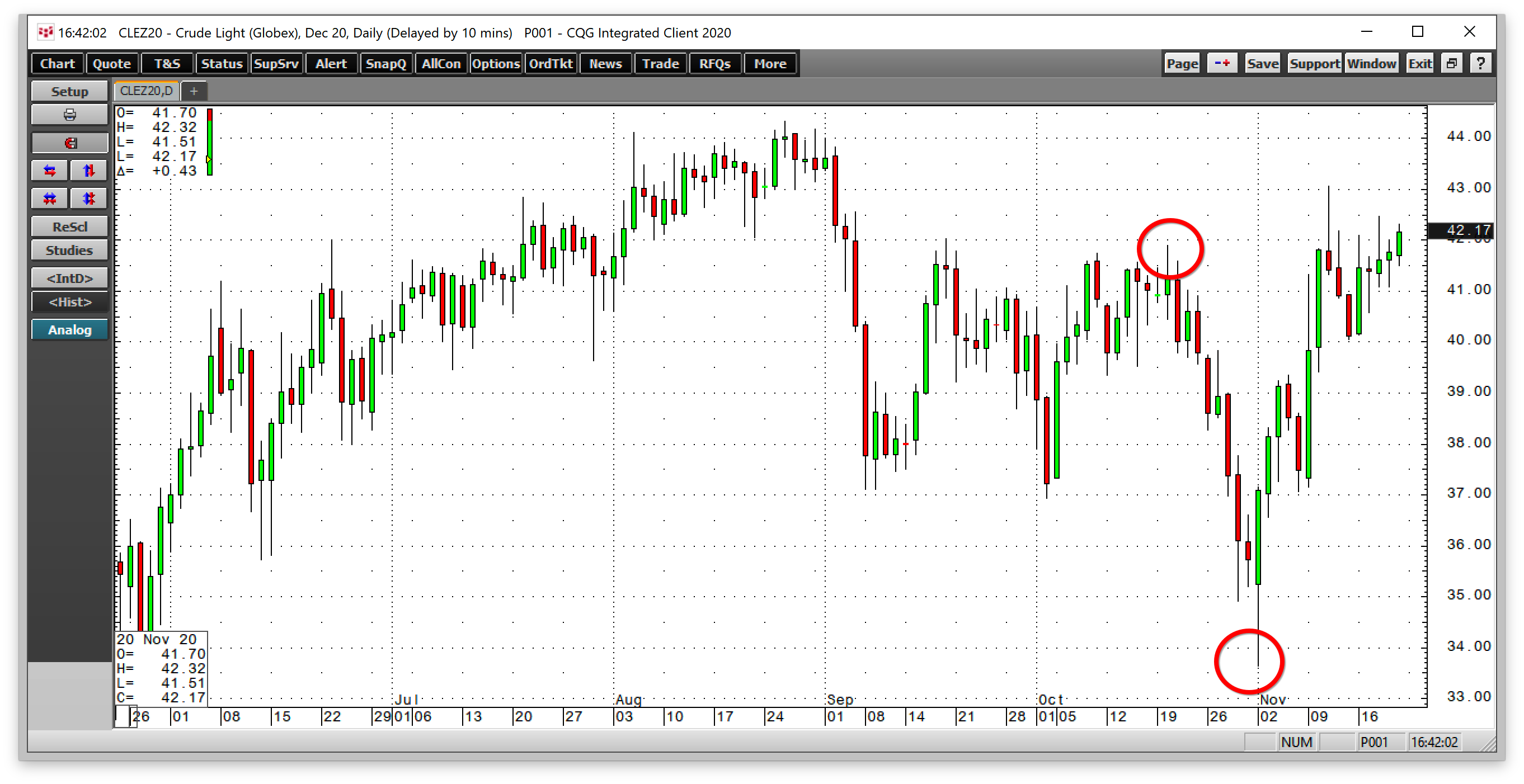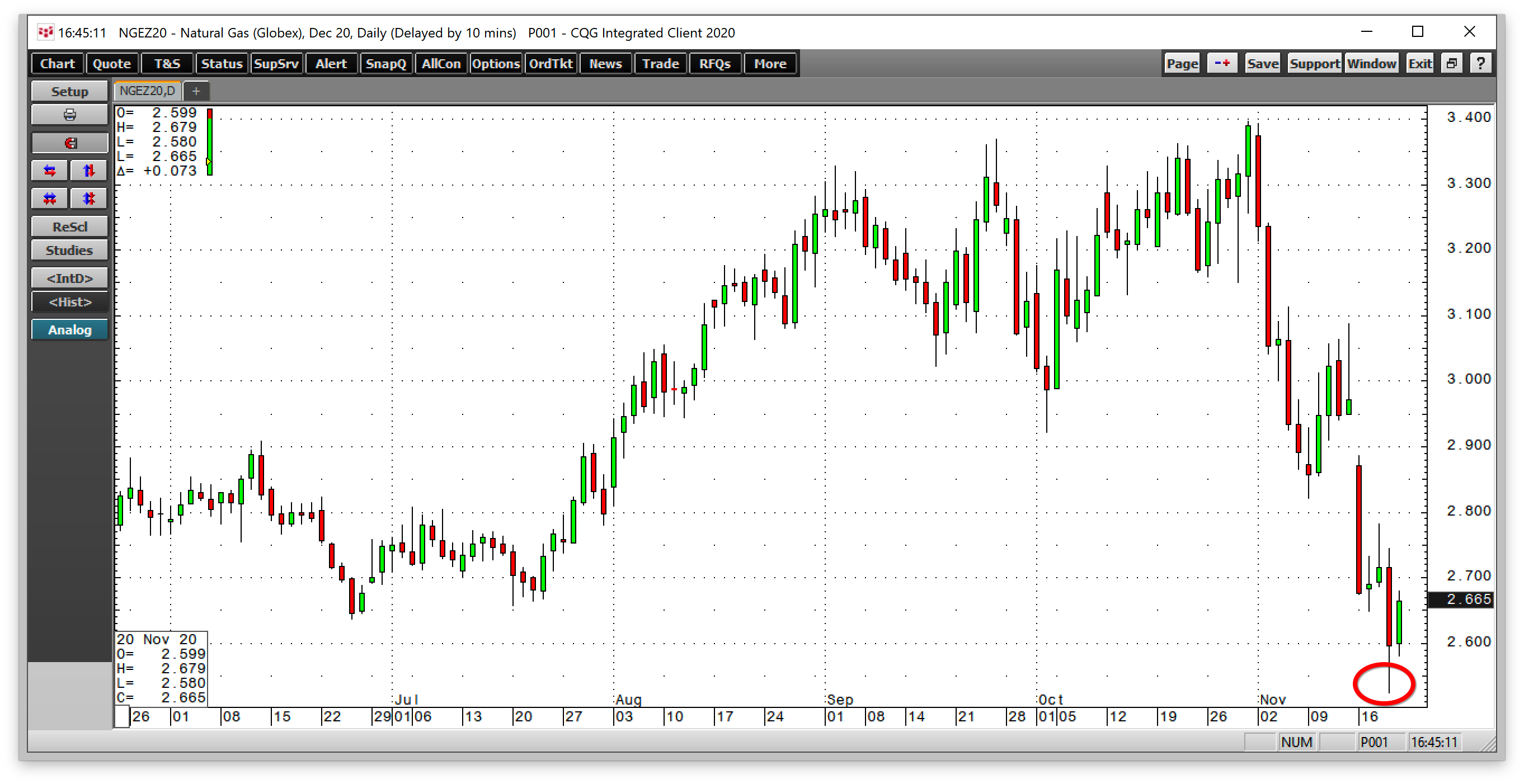This article was written exclusively for Investing.com
- Crude oil returns to $40 per barrel pivot point; XLE makes a comeback
- Natural gas tumbles going into peak demand season
- Runoff election in Georgia will determine US Senate’s majority
- Energy policy will depend on the Jan. 5 special election
- Expect increased volatility in oil and gas futures; vaccine and lower production could cause a rally in energy-related shares
As the US heads into the winter months, energy futures markets tend to encounter seasonality shifts. While crude oil and oil product prices are often weak during the fourth quarter and into the first part of Q1 each year, natural gas frequently goes the other way. The demand for gasoline, the most ubiquitous oil product, declines during the winter months as drivers put less mileage on their vehicles. The requirements for heating rise during the coldest period of the year, pushing natural gas to annual peaks during the early months of the winter season.
But 2020 is not a typical year in markets, and energy is no exception. News of a coronavirus vaccine has increased optimism that there is light at the end of the dark COVID-19 tunnel. However, the number of coronavirus cases and hospitalizations has skyrocketed in Europe and the United States, pulling energy commodities in opposing directions.
Meanwhile, the 2020 US election is now in the market’s rearview mirror. However, a pair of Senate races in Georgia, requiring runoffs, will determine President-elect Joseph Biden's plans for the coming years. Right now he's a Democrat in the White House beginning Jan. 20 with a small majority in the House of Representatives. But the Senate majority will depend on the results of the Georgia runoffs. As Democrats support a green agenda that limits the production and use of fossil fuels, the future regulatory landscape will depend on the new administration’s ability to pass legislation.
The United States is a leading global energy producer. For decades, the nation strived for independence from foreign energy sources. A green approach to US energy could substantially impact oil and gas prices. Therefore, the path of least resistance for crude oil and natural gas futures prices is in the hands of Georgia voters as they go to the polls to elect two Senators on Jan. 5.
Crude oil returns to $40 per barrel pivot point; XLE makes a comeback
Over the past two weeks, Pfizer (NYSE:PFE) and Moderna (NASDAQ:MRNA) each announced their COVID-19 trials had effectiveness rates of 90% and 95%, respectively. And just today, AstraZeneca (NASDAQ:AZN) added to the world's toolkit in its fight against the global pandemic.
Among other things, that's good news for crude oil which tanked earlier this year on an evaporation of demand driven by the pressure of lockdowns and the economic hit that followed. In late April, the price of WTI reached negative territory on the nearby NYMEX futures contract while Brent futures slumped to their lowest prices of this century.
On Oct. 20, January NYMEX crude oil futures reached a high of $41.90 and turned lower. Rising COVID cases in Europe and the US threatened another substantial decline in the price of the energy commodity as it heads into a traditionally weak time of the year during the winter months. 
Source, all charts except where noted: CQG
As the daily chart shows, December futures dropped from $41.90 to a low of $33.64 on Nov. 2. Crude oil reached the lowest level since late May on the day before the US election and turned higher, putting in a bullish reversal on the daily chart.
The news of Pfizer’s vaccine success on Nov. 9 pushed the oil price back over the $40 per barrel pivot point and sent it to the most recent high of $43.06 per barrel on Nov. 11. From the Nov. 2 low to the high on Nov. 11, December futures rose by 28%. Over that period, oil-related shares did even better. The Energy Select Sector SPDR® Fund (NYSE:XLE) holds shares in the leading energy-related companies.

Source: Barchart
While oil was on its way to the Nov. 2 low, the XLE hit a bottom at $26.98 on Oct. 20 before rising to a high of $36.93 on Nov. 18, as the chart above shows, after Moderna released its vaccine trial results. The XLE, which had underperformed both the crude oil and stock market for the previous two years, gained over 36.8%.
Crude oil made a comeback, and oil-related shares moved appreciably higher as we are heading into the winter months, a typically weak time for prices.
Natural gas tumbles going into peak demand season
Meanwhile, the price of natural gas usually climbs as the winter months approach. The peak season for demand typically runs from November through March, when heating requirements rise and inventories decline.
Natural gas experienced its first withdrawal from storage during the week ending Oct. 30. A cold snap led to a decline in stockpiles. However, the stocks experienced marginal increases for the weeks ending on Nov. 6 and 13.
During November 2019, the natural gas price rose to a seasonal high of $2.905 per MMBtu. The nearby NYMEX futures contract rose above that level in October, peaking at $3.396 per MMBtu on Oct. 30, the highest price for the nearby contract since January 2019. Last week, the floor fell from below the natural gas market as the price plunged.

As the chart shows, December natural gas futures fell to a low of $2.525 last week, a drop of 25.6% from the high. Crude oil rallied, and natural gas fell at a time of year when seasonality would dictate the exact opposite price behavior. 2020 is no ordinary year.
Runoff election in Georgia will determine US Senate’s majority
In the aftermath of the Nov. 3 US elections, the majority in the House of Representatives remained in the hands of Democrats who also took the White House. But the election results in the Senate will require the pair of January runoffs in Georgia to determine the majority. The results of the two contests will decide if Republicans end up holding onto a slim majority or if Vice President-elect Kamala Harris has the swing vote to shift the power to Democrats and take the majority leadership role from Senator Mitch McConnell to Senator Chuck Schumer. To gain the majority, both Democratic candidates will need to win their races in Georgia.
Among other things, a majority in the Senate will be the difference between a clean sweep by Democrats or a check and balance on their power going into 2021. When it comes to President-elect Biden’s agenda, his party’s control of both the House and Senate will allow for clear sailing for legislative initiatives. Moreover, the Democrat’s progressive wing would likely push policy to the left as the new President would not have a reason to compromise with Republicans to achieve his goals. The voters in Georgia will decide if the next two years will see a wave of legislation enacted or just gridlock until the 2022 midterm elections.
Energy policy will depend on the Jan. 5 special election
With Republicans favoring a status quo approach to energy independence, which includes fracking for oil and gas, and Democrats favoring a green approach, energy is clearly on the ballot in Georgia at the beginning of January. Moderates seek to phase out fossil fuels, while some progressives advocate for an immediate ban.
While the Biden administration will likely unleash a stricter regulatory environment if Republicans hold the majority in the Senate, we could see significant limits or even bans on fracking under a Senate controlled by Democrats. Therefore, the future of US energy output will depend on the outcome of the Georgia Senate contests.
A sudden decline in US oil and gas production because of a dramatic policy shift could cause prices to move significantly higher as the world continues to depend on hydrocarbons for energy.
Expect increased volatility in oil and gas futures; vaccine and lower production could cause a rally in energy-related shares
I anticipate lots of price variance in the crude oil and natural gas futures markets over the coming weeks, leading up to and after the Georgia runoff elections.
Aside from US politics and the future of energy policy, the rising number of virus cases and hospitalizations is bearish. Progress on a vaccine is bullish as it would restore some sense of normalcy and support more additional for oil and gas.
Moreover, a successful vaccine and end to the pandemic could keep the long-overdue recovery in the XLE and leading energy shares going.
The US is the world’s leading crude oil producer. In March, daily output rose to a record 13.1 mbpd. The EIA’s latest data showed that daily output was just under the eleven mbpd level as of the week ending on Nov. 13. The massive natural gas reserves in the Marcellus and Utica share regions of the US, and the burgeoning LNG market have put the US in a leadership role in the natural gas arena. A sudden shift in production would hand OPEC, Russia, and other world producers a lot more influence on future energy prices.
Over the coming weeks and months, political decisions will determine the future US regulatory environment, the country's oil and gas output, and the path of least resistance for prices. There's a lot at stake in the Jan. 5 elections in Georgia, energy is just one of the many, critical issues.
